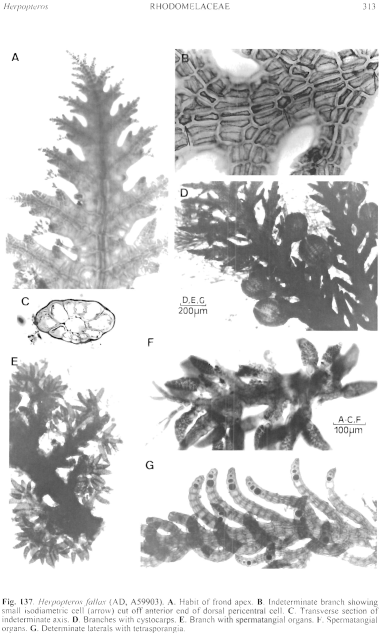|
|
|
|
|
|||||||||||
|
Electronic Flora of South Australia Species Fact Sheet
Phylum Rhodophyta – Family Rhodomelaceae – Tribe Herposiphonieae
Selected citations: Falkenberg 1901: 333, pl. 2 figs 24–26, pl. 3 figs 21–23. De Toni 1903: 1061. Guiler 1952: 106. Kylin 1956: 532, fig. 425. Lucas 1909: 45; 1929a: 23. Lucas & Perrin 1947: 294. May 1965: 381. Saenger 1974: 81. Shepherd & Womersley 1981: 368.
Thallus prostrate, 1–10 (–15) mm long, entirely adherent to the host, axes compressed and irregularly branched, bearing alternate determinate laterals on successive segments (Fig. 137A) with the next segment producing only a single additional cell by transverse division of the central dorsal pericentral cell (Fig. 137B, arrows). Attachment by rhizoids; epiphytic on cartilaginous axes of various hosts. Structure. Apical cells protruding, dome-shaped, 10–20 µm in diameter, segmenting transversely and obliquely to cut off the sequence of determinate laterals. Axes with 10 (–12) pericentral cells, with 2–3 central narrower ones and larger edge ones (Fig. 137C), in face view often appearing 6–7 across (Fig. 137B) due to the compressed nature of the axis but the lateral cells not laterally divided; axes 130–250 µm broad, L/D 0.3–0.8, with the pericentral cells 20–30 (–40) µm in diameter and L/D 2–3. Determinate laterals 600–1000 µm long, alternately pinnate (as in the axes), with the lower branches bearing a trichoblast (Fig. 137A). Trichoblasts 1–1.5 mm long, branched mainly adaxially below, basal cell isodiametric and 20–40 µm across, lower cells elongate and 20–45 µm in diameter. Rhizoids produced by and cut off from the marginal cells of the axes, reflexed to the underside, unicellular with multicellular haptera. Cells uninucleate; rhodoplasts discoid to elongate, often chained.
Reproduction: Gametophytes dioecious. Procarps not observed. Carposporophyte (young) with a basal fusion cell and branched gonimoblast. Cystocarps (Fig. 137D-juvenile) ovoid, 150–200 µm in diameter, sessile on branches of determinate laterals; pericarp ostiolate, 2 cells thick, ecorticate. Spermatangial organs (Fig. 137E, F) in position of trichoblasts, elongate-ovoid and tapering, 90–190 µm long and 35–55 µm in diameter, with sterile basal and apical cells.
Stichidia (Fig. 137G) occur in place of determinate laterals, simple, usually curved, 400–900 µm long and 80–100 µm in diameter, with tetrasporangia in an almost straight row, 45–65 µm in diameter, with 2 elongate cover cells.
Type from Port Phillip and Western Port, Vic. (lectotype to be selected); presumably in Herb. Falkenberg, Naples.
Selected specimens: Elliston, S. Aust., on Heterosiphonia lawrenciana, 7–8 m deep (Shepherd, 27.x.1971; AD, A42446). Tiparra Reef, S. Aust., on Amphibolis, 10–12 m deep (Shepherd, 16.iii.1985; AD, A56446). Hardwicke Bay, S. Aust., on Protokuetzingia, drift (Gordon-Mills, 26.v.1981; AD, A52190). Dany Beach, Corny Point, S. Aust., on Laurencia, drift (Womersley, 15.x.1989; AD, A59903). Aldinga, S. Aust., on Posidonia, 7 m deep (Johnson, 7.vii.1973, AD, A43803). Port Elliot, S. Aust., on Gracilaria cliftonii, drift (Womersley, 23.v.1953; AD, A18758), and on Laurencia, drift (Ricci, 26.ix.1966; AD, A66664). Robe, S. Aust., on Laurencia, drift (Womersley, 23.viii.1960; AD, A24457).
Distribution: Elliston, S. Aust., to Western Port, Victoria.
Taxonomic notes: H. fallax is an inconspicuous but not uncommon epiphyte on cartilaginous red algae or on Amphibolis
References:
DE TONI, G.B. (1903). Sylloge Algarum omnium hucusque Cognitarum. Vol. 4. Florideae. Sect. 3. pp. 775–1521 + 1523–1525. (Padua.)
FALKENBERG, P. (1901). Die Rhodomelaceen des Golfes von Neapel und der angrenzenden Meeres-abschnitte. Fauna und Flora des Golfes von Neapel. Monogr. 26. (Friedländer: Berlin.)
GUILER, E.R. (1952). The marine algae of Tasmania. Checklist with localities. Pap. Proc. R. Soc. Tasmania 86, 71–106.
KYLIN, H. (1956). Die Gattungen der Rhodophyceen. (Gleerups: Lund.)
LUCAS, A.H.S. & PERRIN, F. (1947). The Seaweeds of South Australia. Part 2. The Red Seaweeds. (Govt Printer: Adelaide.)
LUCAS, A.H.S. (1909). Revised list of the Fucoideae and Florideae of Australia. Proc. Linn. Soc. N.S.W. 34, 9–60.
LUCAS, A.H.S. (1929a). The marine algae of Tasmania. Pap. Proc. R. Soc. Tasm. 1928, 6–27.
MAY, V. (1965). A census and key to the species of Rhodophyceae (red algae) recorded from Australia. Contr. N.S. W. Natl Herb. 3, 349–429.
SAENGER, P. (1974). Natural History of the Hogan Group 2. Some marine algae from Hogan Island, Bass Strait, with an account of the marine zonation. Pap. Proc. R. Soc. Tasmania 107, 73–81.
SCHMITZ, F. & FALKENBERG, P. (1897). Rhodomelaceae. In Engler, A. & Prantl, K., Die natürlichen Pflanzenfamilien. T.1. Abt. 2, pp. 421–480. (Englemann: Leipzig.)
SHEPHERD, S.A. & WOMERSLEY, H.B.S. (1981). The algal and seagrass ecology of Waterloo Bay, South Australia. Aquat. Bot. 11, 305–371.
The Marine Benthic Flora of Southern Australia Part IIID complete list of references.
Publication:
Womersley, H.B.S. (24 February, 2003)
The Marine Benthic Flora of Southern Australia
Rhodophyta. Part IIID. Ceramiales – Delesseriaceae, Sarcomeniaceae, Rhodomelaceae
Reproduced with permission from The Marine Benthic Flora of Southern Australia Part IIID 2003, by H.B.S. Womersley. Australian Biological Resources Study, Canberra. Copyright Commonwealth of Australia.
Illustration in Womersley Part IIIA, 2003: FIG. 137.

Figure 137 enlarge
Fig. 137. Herpopteros fallax (AD, A59903). A. Habit of frond apex. B. Indeterminate branch showing small isodiametric cell (arrow) cut off anterior end of dorsal pericentral cell. C. Transverse section of indeterminate axis. D. Branches with cystocarps. E. Branch with spermatangial organs. F. Spermatangial organs. G. Determinate laterals with tetrasporangia.

|
Email Contact: State Herbarium of South Australia |

|